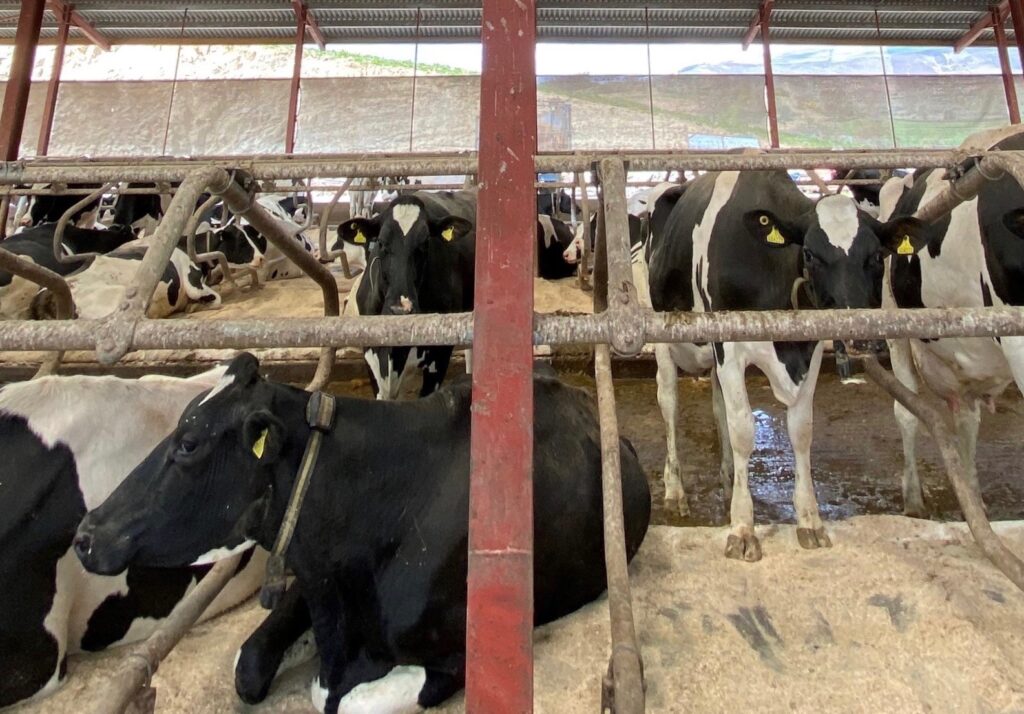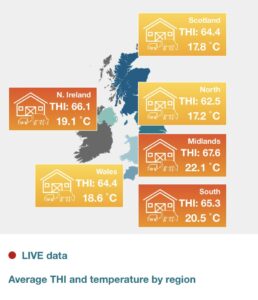High early-June temperatures enough to upset conception rates, data shows
26th June 2021
A network of temperature and humidity monitors, installed by Cargill in cow sheds across the UK this summer, has recorded heat stress conditions in all regions in the first two weeks of June and highlighted levels that could affect cow fertility and milk production.
According to the data, the combined temperature and humidity index (THI) on 10 out of 15 days, from 1st June, was above 65 in the south of England and the Midlands, which is a level known to reduce conception rates. These conditions were recorded on at least three days in the first half of June in the north, Wales and Northern Ireland.
The data explained
“Relative humidity in the UK is normally about 60 per cent,” says Cargill ruminant lead Mark Scott (pictured). “So when temperatures in our cow sheds – or outdoors – exceed 20°C, we get a THI reading of 65. We know from research projects on farm that conception rates can fall if the daily average exceeds this threshold.”
When temperatures exceed 22°C and a THI of 68, milk quality can decline. And at higher temperatures, above 24°C and a THI of 70, cow behaviour will be affected.
Cargill has installed a network of 24 data loggers in cow sheds across the UK, which link to a website and update data every 15 minutes, 24 hours a day. “We’re using these to monitor the average and maximum daily temperatures in six regions,” adds Mr Scott.
“The first two weeks of June illustrated the heat-stress conditions on many of our units, with maximum temperatures above 30°C recorded on consecutive days in the south. A maximum daily THI above 70 was recorded on 11 out of 14 days in the south and Midlands, and on a third of the days in the north and Wales during the first half of June.
“At these levels, cows will spend more time standing in cooler areas rather than lying in cubicles, less time visiting the water trough and feed face, and make fewer visits to automated milking facilities. These all have an impact in intakes and productivity.”
Cargill is publishing this real-time data on a website, which can be freely accessed by dairy farmers and advisers to help them manage heat-stress conditions and mitigate any knock-backs in productivity.
Impacts on fertility and productivity
“Fertility – particularly oestrus and conception rates – are the first parameters affected by heat stress and they are hidden victims, taking a hit at temperatures in the high teens in the British summer,” says Mr Scott. “The effects are not seen immediately on many units and producers may fail to link a drop in rates to increased temperatures. But many producers do see lower fertility rates in summer, suggesting heat stress has had an effect.”
Cargill UK’s ruminant team is encouraging farmers and advisers to use its new website to monitor THI in their area and to pick up any risks of heat stress early, before they affect performance. “And while heat stress can affect grazing cows too, it’s worth noting that the THI in buildings will typically be between two and four points higher than outdoors, depending on building design,” says Mr Scott.
“And cows producing 45 litres of milk a day will produce 26 per cent more body heat than those producing 32 litres a day. This is a serious amount of heat to dissipate when conditions get warmer and more humid. So even when we think that it’s not particularly hot, the THI threshold may be triggered, and our cows could be encountering some heat stress.”
Reducing the risk
Improving the building environment with ventilation and fans, and ensuring fresh feed is available regularly, using the cooler times of the day for feeding during warmer weather, will help to reduce the risk of heat stress in cows.
Many dairy herds are now including a cooling rumen buffer in rations, such as Equaliser CoolCow, to help to mitigate the effects of heat stress. “The buffer element helps to maintain a good rumen environment,” he adds. “The CoolCow elements have been shown to reduce the cow’s internal temperature and keep her hydrated at a cellular level so she can better manage the metabolic challenges that heat stress brings.”
Cargill’s THI website is updated directly from the network of loggers and can be accessed in real-time onhttps://weatherdatauk.provimi.eu/



